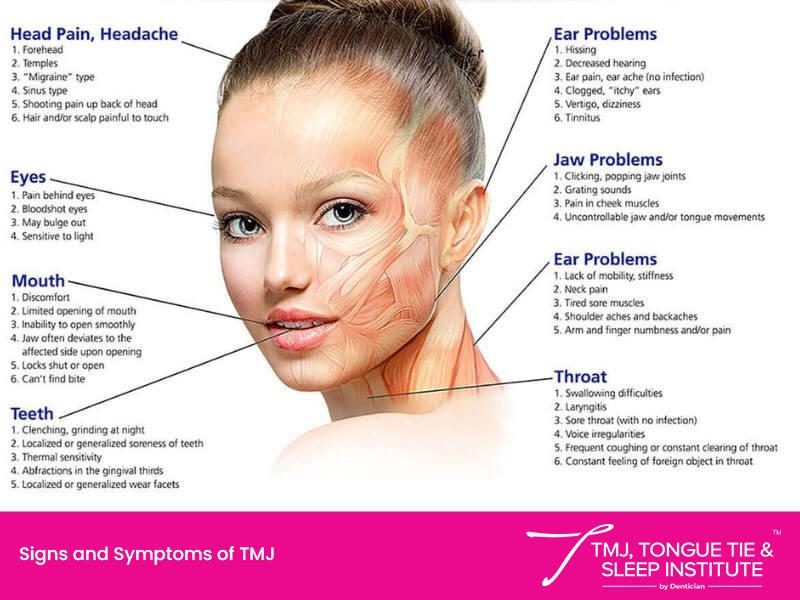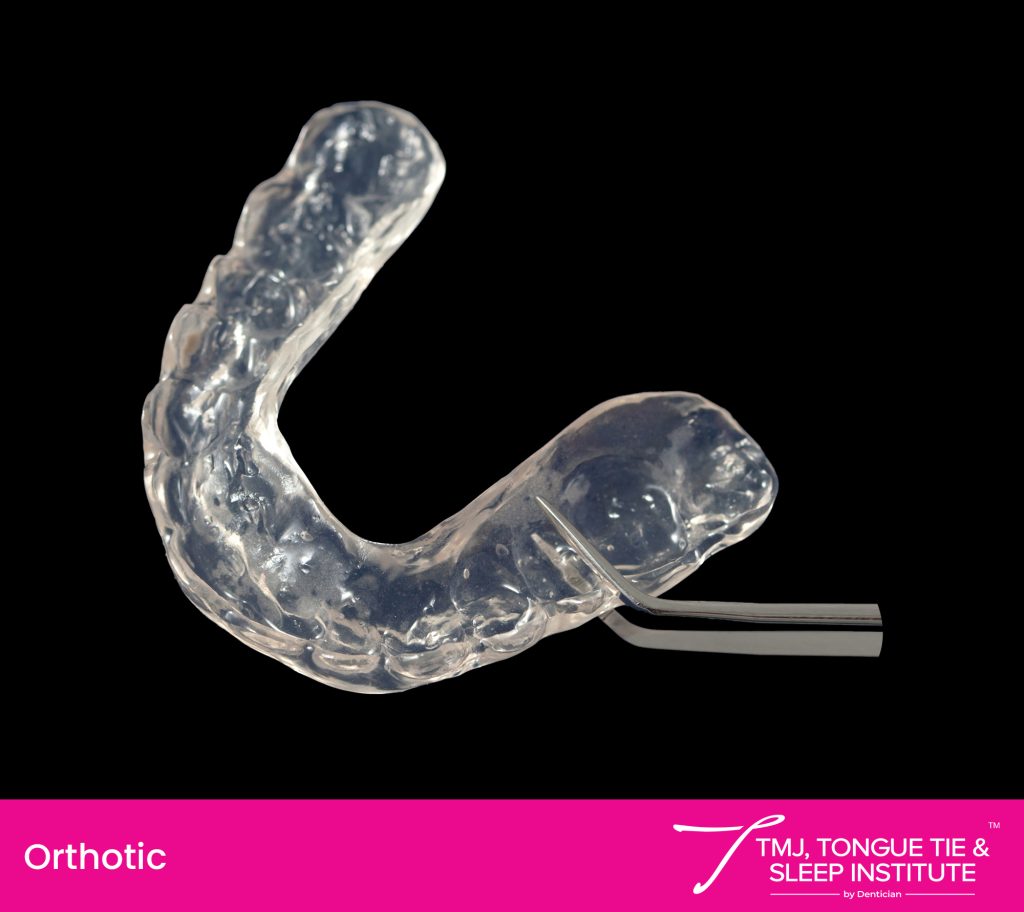

TMJ pain has been reported in 1 in 10 people, and TMD (Temporomandibular Joint Dysfunction or Disorder) has been reported in almost half of the population. It is one of the most common complaints dental practices encounter, and is mostly caused due to malocclusion. Malocclusions is the imperfect positioning of the teeth when the jaws are closed. This imperfect positioning changes the relationship of the mandible to the cranium causing a person to suffer from head, face, neck, shoulder and back pain. Some people can also suffer from subjective hearing loss, ringing in the ears, dizziness, pain in the ear and the feeling of pressure in the ear.
As one of the complex joints in the body, TMJ along with several muscles allows the mandible to move up and down, side to side and forward & back. Thus, it is only when the mandible and joints are aligned, would actions like chewing, talking, yawning, and swallowing become easy and seamless.
However, when these structures, i.e. the muscles, ligaments, disk, jawbones and teeth are not aligned or synchronised, a TMJ disorder (TMD) may occur.
Put an end to your TMJ discomfort. Take our easy TMJ disorder assessment and discover if you need treatment. Get started now!
In TMJ, when you open your mouth to chew, you may hear a clicking/popping sound or experience a painful sensation at many instances and sometimes there is no pain. The pain in TMJ can also radiate towards the head, causing headaches. An individual might feel tenderness and swelling in the jaw joints, pain through the neck and shoulders.
Are you struggling with headaches and migraines? It could be one of the symptoms of TMJ disorder. TMJ disorder could be a result of teeth clenching and grinding, mouth breathing, snoring, sleep apnea, incorrect posture, physical injury, arthritis, malocclusions and improper bite, tongue ties, anxiety, stress, or narrow airways.

Despite these being classified as the common symptoms of TMJ, several TMJ problems might be misdiagnosed as ENT problems and treated as same. This is why patients suffering from TMD, at times, may be misdiagnosed with pyschosomatic disorders.
Ear pain, ear congestion, clogged ear, ear ringing, tinnitus is often caused due to TMJ disorder which is often mistaken as an ENT problem. The TM joint is located close to the ear canal and middle ear and many structures like the muscles, ligaments and fascia are intricately attached from the TMJ to the ear. If these muscles or ligaments get strained or stretched, the disc often dislocates. This causes muscle dysfunction that could lead to lancing or dull ear pain. In order to balance the ear pressure, one reflexively starts to grind their teeth which can worsen the damage to the TMJ.
The pterygoid muscles attach to the bones forming the socket of the eye. These strained muscles can torque the bone which gives rise to pain behind the eyes. Also there are three branches of the trigeminal nerve: Ophthalmic (pertaining to the eye), Maxillary (pertaining to the upper jaw bone) and Mandibular (pertaining to the lower jaw bone). TMJ pain is transmitted through these nerve pathways and can result in pain all over the face too. Thus many symptoms of eye pain such as Retro-orbital Pain (pain behind the eyes), bloodshot eyes, sensitivity to light, may bulge out, eye strain, watery eyes, blurry vision, floaters (small moving spots that you see in your field of vision) and droopy eyelids may be misperceived as ENT problems when they’re signs of TMJ problems.
Trigeminal neuralgia might occur due to a neurological condition such as multiple sclerosis or stroke. Other times, it may occur as the result of a neighboring blood vessel placing pressure along your trigeminal nerve. This pressure wears away the insulating sheath around the nerve, which leads to pain.
Trigeminal Neuralgia differs from TMJ in the aspect that most symptoms of trigeminal neuralgia are unilateral; they occur only on one side of the face. It includes:
There is an existing spatial relationship and structural balance between every structural component in the human body, including the legs, pelvis, back, shoulders, occlusion, TMJ joints, mandible, neck and head. In other words, there is a strong connection between body posture and the mandibular position that is the lower jaw.
Put an end to your TMJ discomfort. Take our easy TMJ disorder assessment and discover if you need treatment. Get started now!
TMD patients need the accuracy and precision of Gneuromuscular Dentistry (GNM) to treat TMJ disorder. GNM is more detailed and customized for the TMD patient compared to NM dentistry. The customized GNM orthotic, used to treat TMJ disorder, is a specifically designed lower jaw splint that helps realign the jaw while also correcting the body posture.

For temporomandibular joint disorder treatment, it is crucial to be screened, diagnosed, and treated by a trained and experienced GNM and OC-trained TMJ dentist in Mumbai. A trained TMJ specialist will focus on the clinical application of neuromuscular principles along with bio- physiological science at a much more advanced level.
Copyright ©2025 TMJ, Tongue Tie and Sleep Institute. All Rights Reserved.
WhatsApp us
Let Us Know How Can We Help You!
At our institute, we take pride in providing complete care for issues related to tongue tie and TMJ. To enhance your quality of life, we treat a range of ailments with state-of-the-art technology and expert care. If you’re searching for an effective tongue-tie operation option or a TMJ specialist in India, you have arrived at the right place.
A tongue tie operation or tongue tie surgery is a life-changing procedure that not only restores tongue mobility but also has a full body effect. While most people associate tongue tie with breastfeeding difficulties in infants, it can also affect speech, breathing, posture, dental health, and sleep patterns in older children and adults. By undergoing this minimally invasive fascia release procedure, patients often experience immediate improvements in functionality and overall well-being.
For individuals considering tongue tie surgery, the benefits are far-reaching:
The Temporomandibular Joint (TMJ) that is your Jaw Joint has a significant impact on one’s quality of life, as they leave the person feeling exhausted and irritable. It not only affects essential functions like chewing, speaking, yawning but also affects one’s posture, breathing and sleep. As a leading TMJ specialist in Mumbai, we offer comprehensive diagnostics and personalized treatment plans to address your unique needs.
An integral part of our treatment protocols is myofunctional therapy. Exercises used in this therapy help to strengthen and coordinate the muscles of the tongue and face. Whether you’re undergoing a tongue tie operation or being treated for TMJ issues, myofunctional therapy plays a pivotal role in ensuring lasting outcomes.
Expertise and complete treatment are essential for treating TMJ issues or tongue tie. Whether you’re searching for the best tongue tie surgery options or a trusted TMJ specialist in Mumbai, we ensure personalized care and transformative results. Don’t let these conditions stop you—reach out to us today to book your consultation and start your journey toward better health and wellness.